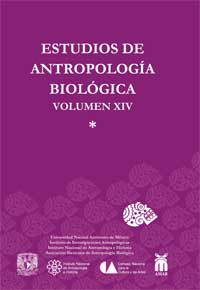Restos humanos mesolíticos en la cordillera cantábrica (Norte de España)
DOI:
https://doi.org/10.22201/iia.14055066p.2009.27244Keywords:
Europe, Iberian Peninsula, Cantabrian Region, Mesolithic, burials, Human remains, shell middensAbstract
The Cantabrian Mountains (Northern Spain) are a key area for the study of the Early Holocene Mesolithic populations, passing from a hunter-gathering to an agricultural subsistence. Numerous caves or rock shelters from this region provide important data both for cultural and anthropological perspectives, with AMS C-14 dates ran-ging from the ixth to the end of the vith millennium BP. The human remains were found in burials or isolated in shell middens, probably because of different taphonomic factors involving tomb destruction. Most individuals were adults, some quite robust, and several display important oral pathology. These findings are important additions to the Iberian and European Mesolithic fossil record
Downloads
Downloads
How to Cite
Issue
Section
License

http://creativecommons.org/licenses/by-nc-nd/4.0/


